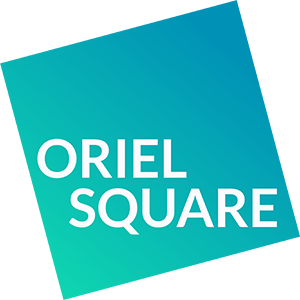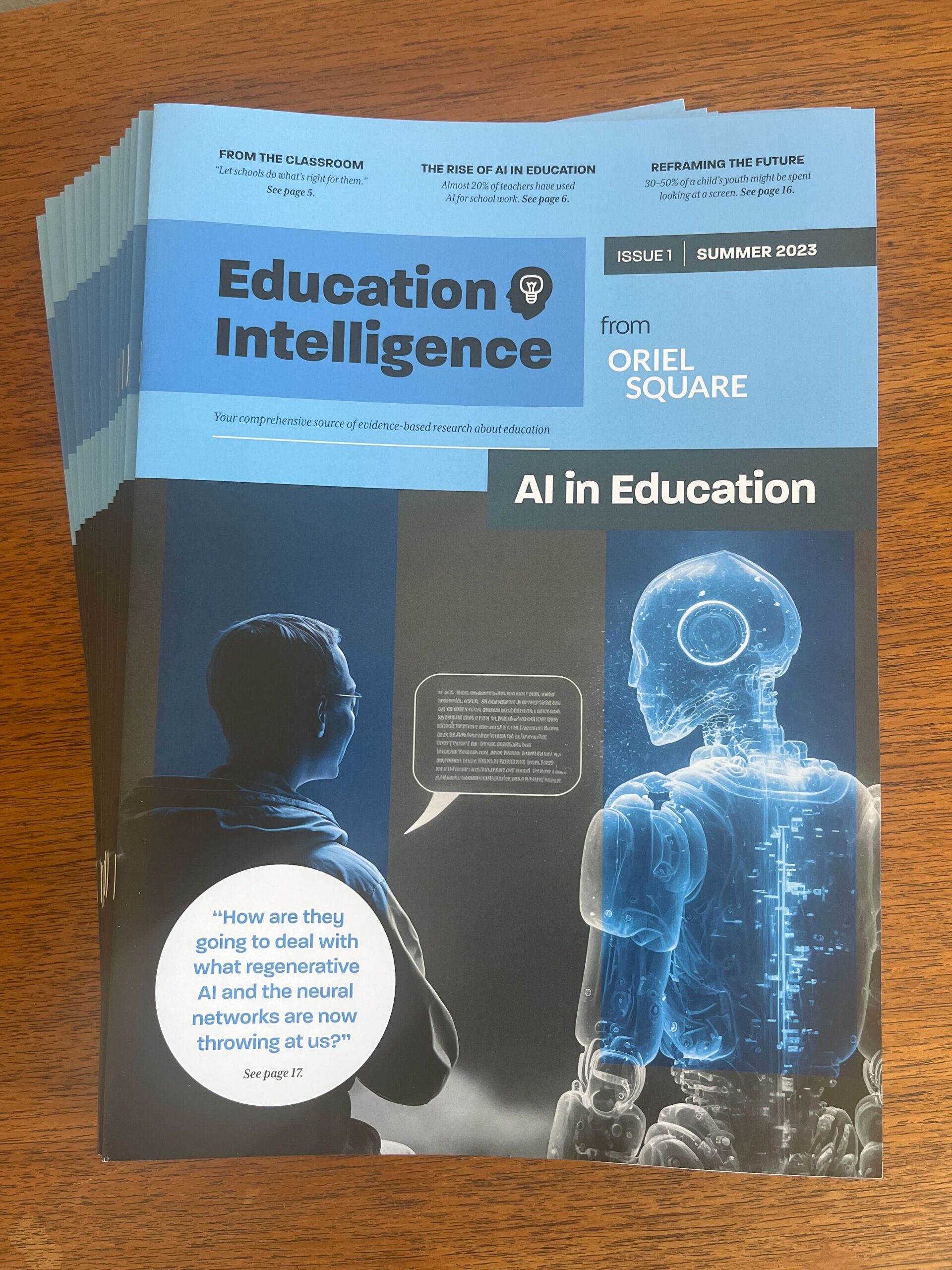On the 19th July, Oriel Square hosted clients from educational publishers, edtech companies, and research think tanks at an event to explore how AI is being used in schools now, and discuss how AI can support educational content development. Here, we report back on the key takeaways and talking points. Read our full report here.
AI and technology in schools now
- 75% of the audience had used ChatGTP this week, compared to 14% of the global population, totalling around 100 million users. In contrast, Facebook Threads reached 100 million users in just five days. The adoption curve for AI and EdTech in schools has followed that outlined by Everett Rogers’ Diffusion Theory in the 1960s. A very small portion of the population – only 2.5% – are ‘innovators’. The majority fall into the ‘early’ or ‘late majority’ groups, adopting the innovation only when convinced of the practical benefits.
- Over half of schools nationally have introduced new technology (hardware or software) into their whole school in the last two years, whereas one in five had had no new tech since before the pandemic. While everyone in the audience said that they had a device for work that they could take away from the office, in 2022, only 75% of teachers said they could take a device away from school with them.
- Most teachers (90%) use tech in lessons on most days, even if this is just an interactive whiteboard or a laptop to run a PowerPoint. There is a massive difference in tech use between primary and secondary schools, with primaries using more iPads, Chromebooks and tablets and secondary classes using IT suites. Often, it is the infrastructure and classroom layouts that set limitations on how students can learn using technology. Before the pandemic, group work was the preferred approach in primary and some secondary classrooms. However, the legacy of the pandemic is that students continue to be seated in rows (introduced for social distancing), which has Implications for how tech is used.
- In the ‘innovators’ and ‘early adopters’ phase of AI use, 20% of teachers say they are using AI to help with school work, with 10% using ChatGTP. The demographics of users correspond with those that Rogers described, with more uptake among ‘wealthier’, younger, males. Teacher Tapp data shows that more men had tried using AI than women and that the ‘laggards’ are those who have been in the profession a long time. Survey responses weren’t grouped by economic status (as this wasn’t asked about) but there was a clear trend showing that teachers in independent schools had a greater awareness of AI. Although AI tools such as Dali and ChatGTP are free, the advantage may come from having fewer classes, fewer students and more time to experiment.
- Asked across three months, Oriel Square’s questions about ChatGPT use, showed that the trend is increasing month on month. However, with teaching constrained by the state, traditions, busyness and funding many are still in the first half of the adoption curve.
AI and educational content development
- Publishing is always going through disruptive change; in the last 20 years, the industry has met the threat of digital, and print publishing processes are now very different from 20 years ago. But, is the threat of generative AI different? Fears about the impact of automation on employment are nothing new, and may give rise to entirely new occupations. There are many worries that have risen to the surface including about our rights ownership model, creativity in the age of AI, or the scope for cheating. But looking to the future, we should acknowledge that it’s not a future dominated by the tools we’ve seen since ChatGTP launched. While the pace of change is rapid, it is nothing compared to what’s ahead.
- In experiments with AI so far, there has been some human element to do the thinking and bridge the gap between what the AI creates and what you want. In examples of using AI to create an image, the AI tools were necessary but the human retains some ownership of the end result.
- Two things make the Large Language Models (LLMs) feel different: the first is the way these tools can mimic human language; the second is the ability for complex spatial reasoning, like drawing pictures. Threats to our jobs and our business models – and opportunities to improve our reach – come from that language ability, such as looking at applications to assist us. For example, for an article in the Education Insights report, Oriel Square asked the AI to analyse the information we gave it, so we avoided generating AI-hallucinated content.
Part two: A Q&A with the experts
Do you think teachers will move to products which use AI?
Asking them outright will produce different results as they might not label the products they’re using as AI. This is similar to how primary teachers say they don’t use CogSci (cognitive science) but say they do interleaving and quizzing in every lesson. They might not label or notice it, but AI will certainly be part of the other systems they use.
Do you have any data on what teachers are using AI tools for?
The results from Oriel Square’s research showed that they’re mostly using AI to create resources for the classroom, for assessment and for marking. They can also see lots of potential areas for use but aren’t using AI tools a lot yet.
Have you asked about teachers’ attitudes to AI and its impact?
40% thought their school would never adopt AI but they saw opportunities to use it or thought they might use it in the future. However, there were fears over plagiarism and dealing with that, which many are already facing in the classroom and there are societal issues about regulation.
One English teacher who came to Oriel Square’s roundtable event (see pages 14–15), has stopped assigning essays that aren’t done in class as she couldn’t monitor cheating otherwise. Teachers can spot when students have used AI to write an essay or do their homework, but they don’t have any policies in place for how to deal with it. It would become a lot harder for teachers to spot AI use when they don’t know the student whose work they are marking.
Do you have any data from teachers working outside the UK?
We ran the same questions in the Netherlands and Belgium, but these were mainly International and fee-paying schools, which are further along the adoption curve. In the US, 50% of teachers have tried it, and adoption is higher in International schools where a 1-2-1 device is common. IB schools are hot on AI and in Asia schools are more open to adopting new tech.
UK teachers are used to generating materials, but other markets might not expect this. UK teachers like to adapt resources and they are used to this step of customization as their norm.
How much training is coming from schools/MATS?
Almost no one had had training or guidance on using AI; where they had it was informal or they had found it themselves. There is a huge gap already forming because many headteachers don’t know what to do, and the DfE is not creating guidance.
Greg Hughes, who spoke at our teacher event, has provided materials for teachers at his Trust to use, and had created a Statement of Intent about the use of AI in his Trust, but felt very few MATs had done something similar (read more on pages 14–15).
What does AI mean for educational content creation?
We have to ask ourselves what we can do to add value even though these tools exist to create content. We have to accept that AI programmes will end up doing jobs humans used to do. We should feel empowered that we know best how those tools can support us and our work.
We need to identify what we struggle with – e.g. processing large amounts of data or spotting themes or the way we structured content – and ask ourselves how we can use AI tools to make those tasks better or quicker.
How hopeful do you feel about our ability to educate young people responsibly
It is exciting that you can do so many things to teach AI that aren’t on a computer, such as teaching critical thinking skills and asking students to challenge where the data comes from. We don’t do that well already so there is a disruptive opportunity.
While we’re settling into ChatGTP and getting used to it, Is there another evolution that will take AI in a different direction?
Other models are making huge progress but are not as evident as not large language models. However, there is a limit to an LLM’s data; as it produces and publishes more and more content, we have to look at where new language and artwork come from as there is a risk of generative AI consuming its own exhaust.
AI in education report
Our inaugural Education Insights report, AI in education, brings together the most up to date insights from the classroom and from thought leaders in education. Read our full report here.

